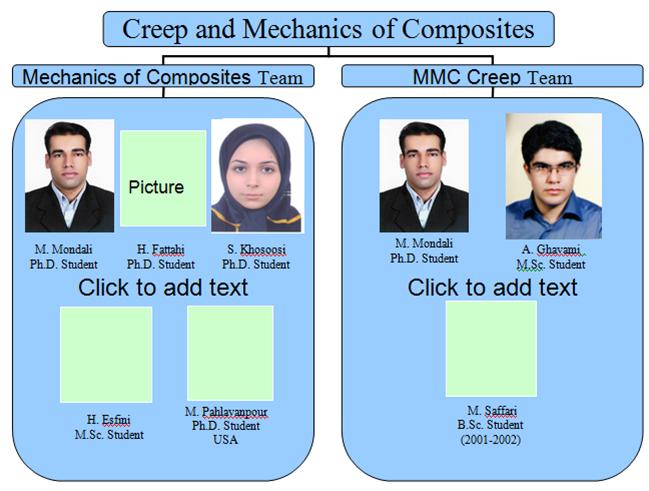

|
Research groups |



|
به نام خداوند جان و خرد سخنی از قرآن کریم |
|
Mechanics of Composite Materials - Summary Motivations:
· Precise estimation of the mechanical properties or stress distribution in short fibre composites are highly in demand · An analytical tool is the key for the precision in request · Exact stress distribution in composite constituents is essential in creep calculations · The existing methods for short fibre composites which make use of Imaginary Fibre Technique calculate the stresses independent of the r-dir.
Objectives:
· Developing an analytical tool for 3-D calculation of elastic stress fields in short fibre composites subjected to axial loads. · The method here takes the r-dependency of the solution into account · The fibre/matrix debonding, which is an inseparable phenomenon in short fibre composites, is also included
Results:
· The derived analytical expressions for the matrix and fibre stress fields satisfy exactly both equilibrium and compatibility conditions of the theory of elasticity. · Since here the interface continuity conditions and the axial force equilibrium conditions are considered, the overall equilibrium is ensured rigorously within the fibre, the matrix, and between the fibre and matrix. · This treatment of the problem provides clear insights into the stress transfer mechanisms in short fibre composites. · The present analytical solution can be applied directly to the similar stress transfer analysis in continuous fibre composites. · This modified model has also a good potential for investigation of interfacial and fibre/matrix debonding problems.
Publications:
1) Abedian, A., Mondali, M., Pahlavanpour, M., "Basic modifications in 3D micromechanical modeling of short fiber composites with bonded and debonded fiber end", Computational Materials Science, Vol. 40, pp. 421-433, 2007. 2) Pahlavanpour, M., Abedian, A., Mondali, M., "A Modified Three-Dimensional Analytical Model for Stress Prediction in Short Fibre Composites", 8th International Conference on Computational Structures Technology, Las Palmas de Gran Canaria, Spain, 2006.
Creep Analysis of MMC’s - Summary Motivations:
· Since MMC’s are used in high temperature-high mechanical loading environments their long term response to such loadings is of great concern · Most of the available studies in this area are experimental which is a time consuming and costly approach · Most of the available FEM studies were only able to predict the same power for creep behaviour of composites as those for the matrix materials (e.g. in a power law creep description). · Developing of a more precise FEM modelling is highly in demand
Objectives:
· Predicting the creep response of MMC’s both numerically and analytically · The study was performed using FEM, Finite Difference, and analytical approaches. · Inclusion of the debonding phenomenon (which is an inseparable part of MMC’s) to the simulations
Results:
· Careful inclusion of some of the analytical findings in the FEM micro-mechanical modelling predicted fairly close creep behaviour for the MMC to the experimental results · Further, introduction of the debonding phenomenon to the modelling along with employing exponential creep law caused an excellent convergence of the FEM results and the experimental data · In contrast to the analytical studies, the FEM study shows that the debonding parameter can only change between 0< <0.5, i.e. fibres which have half of their lengths debonded are ineffective in creep · The analytical solution satisfies all the equilibrium and constitutive creep equations and the results perfectly match the FEM results
Publications:
1) Mondali, M., Abedian, A., Ghavami, A."A new analytical shear-lag based model for prediction of the steady state creep deformations of short fiber composites", Materials & Design, 2008 (In Press). 2) Mondali, M., Abedian, A., Adibnazari, S., "FEM study of the second stage creep behavior of Al6061/SiC metal matrix composite", Computational Materials Science, Vol. 34, pp. 140-150, 2005. 3) Mondali, M., Abedian, A., Ghavami, A."An analytical model for stress analysis of short fiber composites in power law creep matrix" submitted to the journal of Computational Material Science (CMS) for possible publications. 4) Abedian, A., Mondali, M., Saffari, P., "Effects of the Geometric Parameters on the Creep Behavior of MMC Composites", Proceeding of the 4th International Conference of the Iranian Aerospace Society, Tehran, Iran, 2003.
|